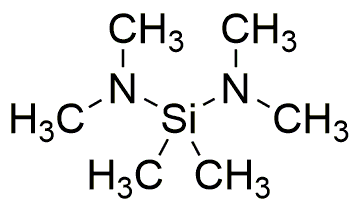Bis(dimethylamino)dimethylsilane is widely utilized in research focused on:
- Silicone Production: This compound serves as a key intermediate in the synthesis of silicone polymers, which are used in a variety of applications including sealants, adhesives, and coatings due to their flexibility and durability.
- Surface Modification: It is employed in modifying surfaces to enhance properties such as hydrophobicity and adhesion, particularly in the electronics industry for improving the performance of semiconductor devices.
- Chemical Synthesis: Researchers use it as a reagent in organic synthesis, facilitating the creation of complex molecules in pharmaceuticals and agrochemicals, thereby streamlining production processes.
- Nanotechnology: This chemical plays a role in the development of nanomaterials, where it aids in the functionalization of nanoparticles, enhancing their stability and reactivity for applications in drug delivery and diagnostics.
- Research in Catalysis: It is used in catalysis research, particularly in the development of new catalysts for chemical reactions, offering advantages in efficiency and selectivity compared to traditional catalysts.
General Information
Properties
Safety and Regulations
Applications
Bis(dimethylamino)dimethylsilane is widely utilized in research focused on:
- Silicone Production: This compound serves as a key intermediate in the synthesis of silicone polymers, which are used in a variety of applications including sealants, adhesives, and coatings due to their flexibility and durability.
- Surface Modification: It is employed in modifying surfaces to enhance properties such as hydrophobicity and adhesion, particularly in the electronics industry for improving the performance of semiconductor devices.
- Chemical Synthesis: Researchers use it as a reagent in organic synthesis, facilitating the creation of complex molecules in pharmaceuticals and agrochemicals, thereby streamlining production processes.
- Nanotechnology: This chemical plays a role in the development of nanomaterials, where it aids in the functionalization of nanoparticles, enhancing their stability and reactivity for applications in drug delivery and diagnostics.
- Research in Catalysis: It is used in catalysis research, particularly in the development of new catalysts for chemical reactions, offering advantages in efficiency and selectivity compared to traditional catalysts.
Documents
Safety Data Sheets (SDS)
The SDS provides comprehensive safety information on handling, storage, and disposal of the product.
Product Specification (PS)
The PS provides a comprehensive breakdown of the product’s properties, including chemical composition, physical state, purity, and storage requirements. It also details acceptable quality ranges and the product's intended applications.
Certificates of Analysis (COA)
Search for Certificates of Analysis (COA) by entering the products Lot Number. Lot and Batch Numbers can be found on a product’s label following the words ‘Lot’ or ‘Batch’.
*Catalog Number
*Lot Number
Certificates Of Origin (COO)
This COO confirms the country where the product was manufactured, and also details the materials and components used in it and whether it is derived from natural, synthetic, or other specific sources. This certificate may be required for customs, trade, and regulatory compliance.
*Catalog Number
*Lot Number
Safety Data Sheets (SDS)
The SDS provides comprehensive safety information on handling, storage, and disposal of the product.
DownloadProduct Specification (PS)
The PS provides a comprehensive breakdown of the product’s properties, including chemical composition, physical state, purity, and storage requirements. It also details acceptable quality ranges and the product's intended applications.
DownloadCertificates of Analysis (COA)
Search for Certificates of Analysis (COA) by entering the products Lot Number. Lot and Batch Numbers can be found on a product’s label following the words ‘Lot’ or ‘Batch’.
*Catalog Number
*Lot Number
Certificates Of Origin (COO)
This COO confirms the country where the product was manufactured, and also details the materials and components used in it and whether it is derived from natural, synthetic, or other specific sources. This certificate may be required for customs, trade, and regulatory compliance.


